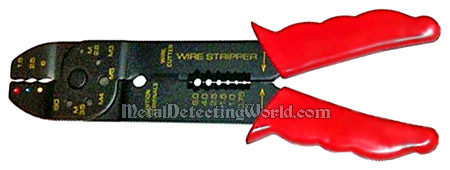GeorgeB
ElectroHydraulics engineer (retired)
- Location
- Greenville SC
- Occupation
- Retired
Might use that instead. But how far off am I with these?

the red/blue/white (if I see them correctly) squeeze as they "should"
Might use that instead. But how far off am I with these?

FIFYthe red/blue/yellow squeeze as they "should"
I use a "generic" version of that tool. Identical in every way but the plastic handle grips. Picked it up at Advance Auto for $20 maybe 15-20 years ago. I just checked their website and it now goes for $30.This is my go to tool for crimping insulated terminals.
Put the wire into the side with the color dots. I keep correcting people I work with. The old " when all else fails and the wire pulls out, read the directions!"
http://idealind.com/ideal-electrica...l-with-insulated-terminal-die-set-30-500.aspx
You can also get dies for uninsulated terminals, coax fittings, RJ series.....
the red/blue/white (if I see them correctly) squeeze as they "should"
Put the part number into Google and you'll get at least 100 hits ... here's the manual ... http://www.mouser.com/ds/2/418/NG_SS_408-8620_C-116043.pdf
Here, from the instructions, is a picture.
I use StaKon pliers which indent ... even when I shouldn't.
Someone's been rooting around in my tool bag!
Is that commercial electric?
Yeah, I think so. I gave up on Kleins after yet another pair was unfit for professional work. It's a coinflip if they'll be loose enough to operate to begin with. I'm not paying $50 for a pair of pliers that MIGHT last two years when I can pay $17 that will at least last a year. I've had my current pair for over a year.
To be honest, I am thinking of getting a new pair.
electricians seem to like the plier type tools because they are cheap and fast.
if not done correctly and consistently though, you can have problems which is why most engineers specify a controlled cycle crimper that makes the crimp exactly the same way every time and entirely removes the human variability that would otherwise exist.
It is not just "less experienced" persons that are a problem.Which yields perfect results since they do not "indent", however technicality says not good enough as I am reading. Is this simply because a less experienced person can cause an error?
It is not just "less experienced" persons that are a problem.
Anyone can have a bad day and either crimp it too hard or too soft with a pliers type tool.
It is almost impossible to do that with a controlled cycle tool.
Some electricians are either too cheap or too lazy to go get the right tool for the job and insist on using plier type tools claiming that their skill can make up for the lack of precision in the tool. They are just wrong about that. The tool is far better at crimping than their skill will ever be, and does not get tired or get distracted and screw up like people do. That is why we have these kind of tools.
OTOH, it probably does not matter all that much and I don't get real excited about it. I am more worried about the cheapskates that will use terminals with the unwelded barrel.
What is an unwelded barrel?
Brazed or Overlapped Seam
A long barrel design is of little value
unless it is one solid piece. That is why
Thomas & Betts brazes the seam on
our vinyl insulated Sta-Kon®
and over-laps the seam on nylon insulated termi-
nals. Many competitive terminals have
butted seams. This means increased
chances for wirestrand loss, poor resis-
tance, wire pullout and electrical fail-
ure. If the installer doesn’t position the
tool exactly on the correct spot on the
barrel, there’s likely going to be an
improper termination. The butted seam
can also fold due to tool-applied pres-
sure piercing the terminals insulation
from the inside out. With a brazed or
overlapped seam the installer can
crimp anywhere along the barrel’s sur-
face providing up to 2.5 times the ten-
sile strength of a butted seam terminal,
guaranteeing proper electrical flow,
void free
It is not just "less experienced" persons that are a problem.
Anyone can have a bad day and either crimp it too hard or too soft with a pliers type tool.
It is almost impossible to do that with a controlled cycle tool.
Some electricians are either too cheap or too lazy to go get the right tool for the job and insist on using plier type tools claiming that their skill can make up for the lack of precision in the tool. They are just wrong about that. The tool is far better at crimping than their skill will ever be, and does not get tired or get distracted and screw up like people do. That is why we have these kind of tools.
OTOH, it probably does not matter all that much and I don't get real excited about it. I am more worried about the cheapskates that will use terminals with the unwelded barrel.
DMashing em with Kleins is a great method... to ensure a lousy connection and callbacks.
Interesting timing. I've been looking at getting a cheap pin-crimper for emergency repair situations where I don't have the right crimp tools.
While I have seen very obviously ugly crimps, and agree they can be done poorly, I can't decide how much I believe the idea that crimps will only ever be correctly made by matching UL lug/die sets.
There are quite a few dieless sets on the market that just seem to work via high, uniform pressure. The brand of lug seems less important?
